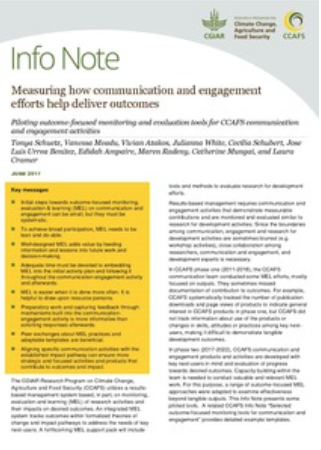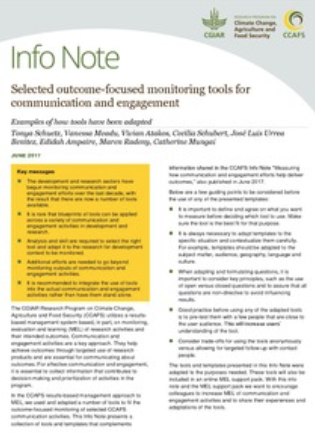Communication and engagement strategies to help move 150 million people out of hunger

Two briefs explore how CGIAR Research Programs can measure the contribution of communications and engagement activities to development outcomes.
In 2017 CGIAR launched seven agri-food and four integrating research programs designed to reduce by 150 million the number of people suffering from hunger in developing nations. The CGIAR Portfolio 2017-2022 is the second generation of CGIAR’s Research Programs and Platforms aimed at reducing rural poverty, improving food and nutrition security and improving natural resources and ecosystem services.
The CGIAR Research Program on Climate Change, Agriculture and Food Security (CCAFS), with several hundred partners at sub-national, national, regional, and global levels, is generating evidence and supporting adoption of climate-smart agricultural policies, practices and services that alleviate poverty, increase gender equity, and support sustainable landscapes.
The CCAFS communications and engagement strategy employs a suite of tools and approaches to deliver tailored messages to program partners and appropriate, interested groups and individuals. CCAFS communications activities disseminate information and help shape attitudes, and thus contribute to the behavioural changes needed to deliver impact.
CCAFS is undertaking a systematic effort to monitor and evaluate communications activities to learn what is most effective. Assessment and reporting back from information campaigns and activities help communicators measure success based on quantitative and qualitative indicators determined during the planning phase. These findings then help the program make decisions on budgets, strategy and future event planning.
 Monitoring, evaluation and learning specialists and communicators from CCAFS recently released two briefs on the subject. The first brief shares lessons learned and makes suggestions for incorporating monitoring, evaluation, and learning into communications and engagement activities in research for development programs.
Monitoring, evaluation and learning specialists and communicators from CCAFS recently released two briefs on the subject. The first brief shares lessons learned and makes suggestions for incorporating monitoring, evaluation, and learning into communications and engagement activities in research for development programs.
Lead author Tonya Schuetz said,
Our monitoring, evaluation and learning efforts aim to gain insights of effectiveness and efficiency at two levels: first, our communication and engagement activities, and second, our outcome-focused monitoring and evaluation tools to assure and allow for assessment of our communications and engagement activities.”
 The second brief describes and provides examples of tools used to monitor, evaluate and learn from communication and engagement activities in CCAFS’s research for development context. The authors recognize that most of the tools must be adapted to be applied to specific activities, and they recommend adapting and integrating the tools when the activity is being planned.
The second brief describes and provides examples of tools used to monitor, evaluate and learn from communication and engagement activities in CCAFS’s research for development context. The authors recognize that most of the tools must be adapted to be applied to specific activities, and they recommend adapting and integrating the tools when the activity is being planned.
As CCAFS enters its second phase, communicators will continue to produce and share reports from campaigns and activities to measure success based on quantitative and qualitative indicators determined during the planning phase. The aim is to spend donor resources wisely and achieve outcomes more effectively and efficiently.



